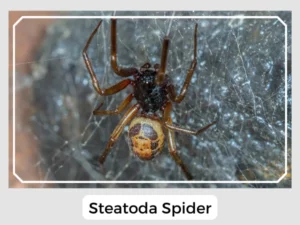Meet the Steatoda spiders! They’re part of the cobweb spider family and there are around 120 different types. Some, like the Steatoda borealis, look a lot like widow spiders. But don’t be fooled! Even though they look similar, Steatoda spiders aren’t as harmful to humans. Ready to discover more about them?
Steatoda paykulliana of this genus has an orange or reddish marking on its back, which compels people to take it for the highly venomous redback spider.
The eggs of most species of this genus could be pale yellow, cream, or even whitish. The shapes also vary from round to oval or even spherical.
Most of the spiderlings like those of the Steatoda grossa detach from their mother immediately after dispersal,
They build webs in dark and secured places that are tangled and three-dimensional, comprising sticky silken fibers joined in an irregular fashion.
Yes, Steatoda spiders have venom. However, it’s not as strong as some other spiders, like widow spiders. Some species of this genus, like the Steatoda grossa, and Steatoda nobilis, are known for their venomous bite, whose effect, however, spans between one and sixty hours.
Steatoda spiders can bite if they feel threatened. The bite might cause some discomfort with other mild to moderate symptoms including headache, lethargy, and nausea but it’s not usually very severe for most people.
Steatoda spiders play a crucial role in controlling the population of pests in their habitats. They prey on woodlice, cockroaches, ladybugs, crickets, and even other spiders, including the black widow. Their preference for dark, undisturbed places such as garages, backyards, and cupboards, makes them a natural form of pest control in human dwellings.
Natural Predators and Prey-Predator Dynamics: In the wild, Steatoda spiders are not without their adversaries. Birds and larger mammals pose a constant threat. However, their ability to remain concealed in dark, secluded areas provides them with a significant advantage, allowing them to avoid predators while stalking their prey.
Relationship with Humans: Commonly found in close proximity to human dwellings, Steatoda spiders have developed a unique relationship with us. Often referred to as cupboard spiders, they tend to spin their webs in the dark, undisturbed corners of houses, gardens, garages, and bins. While their bite can cause discomfort, it is generally not severe, and their presence helps in keeping the population of other pests at bay.
| Other Names | Cupboard spider |
| Distribution | Africa, America, and Asia |
| Habitat | Garages, backyards, undisturbed places |
| Diet | Woodlice, cockroaches, ladybugs, crickets, and other spiders including black widow |
| Web Type | Cobwebs |
| Lifespan | 1-2 years |
| IUCN Red List Status | only 1 species currently assessed [0.8% of genus] |

In summary, Steatoda spiders offer a fascinating glimpse into the world of arachnids.
Meet the Steatoda spiders! They’re part of the cobweb spider family and there are around 120 different types. Some, like the Steatoda borealis, look a lot like widow spiders. But don’t be fooled! Even though they look similar, Steatoda spiders aren’t as harmful to humans. Ready to discover more about them?
Steatoda paykulliana of this genus has an orange or reddish marking on its back, which compels people to take it for the highly venomous redback spider.
The eggs of most species of this genus could be pale yellow, cream, or even whitish. The shapes also vary from round to oval or even spherical.
Most of the spiderlings like those of the Steatoda grossa detach from their mother immediately after dispersal,
They build webs in dark and secured places that are tangled and three-dimensional, comprising sticky silken fibers joined in an irregular fashion.
Yes, Steatoda spiders have venom. However, it’s not as strong as some other spiders, like widow spiders. Some species of this genus, like the Steatoda grossa, and Steatoda nobilis, are known for their venomous bite, whose effect, however, spans between one and sixty hours.
Steatoda spiders can bite if they feel threatened. The bite might cause some discomfort with other mild to moderate symptoms including headache, lethargy, and nausea but it’s not usually very severe for most people.
Steatoda spiders play a crucial role in controlling the population of pests in their habitats. They prey on woodlice, cockroaches, ladybugs, crickets, and even other spiders, including the black widow. Their preference for dark, undisturbed places such as garages, backyards, and cupboards, makes them a natural form of pest control in human dwellings.
Natural Predators and Prey-Predator Dynamics: In the wild, Steatoda spiders are not without their adversaries. Birds and larger mammals pose a constant threat. However, their ability to remain concealed in dark, secluded areas provides them with a significant advantage, allowing them to avoid predators while stalking their prey.
Relationship with Humans: Commonly found in close proximity to human dwellings, Steatoda spiders have developed a unique relationship with us. Often referred to as cupboard spiders, they tend to spin their webs in the dark, undisturbed corners of houses, gardens, garages, and bins. While their bite can cause discomfort, it is generally not severe, and their presence helps in keeping the population of other pests at bay.
| Other Names | Cupboard spider |
| Distribution | Africa, America, and Asia |
| Habitat | Garages, backyards, undisturbed places |
| Diet | Woodlice, cockroaches, ladybugs, crickets, and other spiders including black widow |
| Web Type | Cobwebs |
| Lifespan | 1-2 years |
| IUCN Red List Status | only 1 species currently assessed [0.8% of genus] |

In summary, Steatoda spiders offer a fascinating glimpse into the world of arachnids.